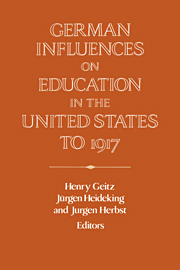Book contents
- Frontmatter
- Introduction
- PART ONE AMERICANS AND GERMANS LOOK AT EACH OTHER'S SCHOOLS
- PART TWO VARIETIES OF TEACHERS AND STYLES OF TEACHING
- PART THREE GERMAN SCHOOLS IN AMERICA
- PART FOUR THE GERMAN INFLUENCE ON HIGHER EDUCATION
- 11 American Students in Germany, 1815-1914: The Structure of German and U.S. Matriculants at Göttingen University
- 12 Philip Schaff: His Role in American Evangelical Education
- 13 German Influence on the Higher Education of American Women, 1865-1914
- 14 Basil L. Gildersleeve: The Formative Influence
- 15 A Mediator between Two Historical Worlds: Hermann Eduard von Hoist and the University of Chicago
- 16 German Influences on American Clinical Medicine, 1870-1914
- Index
16 - German Influences on American Clinical Medicine, 1870-1914
Published online by Cambridge University Press: 05 January 2013
- Frontmatter
- Introduction
- PART ONE AMERICANS AND GERMANS LOOK AT EACH OTHER'S SCHOOLS
- PART TWO VARIETIES OF TEACHERS AND STYLES OF TEACHING
- PART THREE GERMAN SCHOOLS IN AMERICA
- PART FOUR THE GERMAN INFLUENCE ON HIGHER EDUCATION
- 11 American Students in Germany, 1815-1914: The Structure of German and U.S. Matriculants at Göttingen University
- 12 Philip Schaff: His Role in American Evangelical Education
- 13 German Influence on the Higher Education of American Women, 1865-1914
- 14 Basil L. Gildersleeve: The Formative Influence
- 15 A Mediator between Two Historical Worlds: Hermann Eduard von Hoist and the University of Chicago
- 16 German Influences on American Clinical Medicine, 1870-1914
- Index
Summary
When Abraham Flexner came to Munich in 1910, he wrote his wife about the powerful impression made upon him by a lecture given by the internist Friedrich von Miiller. “He delivered a wonderful lecture,” Flexner wrote, “his text a patient, after examining whom, he turned to the class with a discourse on infectious diseases as such. The case was of an obscure infection: that made his theme. He swept the whole field, working it out in broad, clear strokes, illustrating, differentiating, summarizing, - and yet ever keeping both concrete, never vague, never abstract.”
In his resulting study of medical education in Europe, Flexner paid tribute to the clinical teaching and investigation of the German universities. The German clinician, unlike the clinical teacher in the United States, was a research scientist, a full-time university scholar, one who devoted his life to the natural history of disease. “In a soundly organized university,” he told his readers, “the medical faculty is in the position of any other faculty, - that of arts, of philosophy, or of science,” and “within the medical faculty there is no distinction in kind between the professors of the fundamental or theoretical branches - anatomy and pathology, for example - and the professors of the clinical or practical branches - medicine, surgery, and obstetrics.” While the professor of medicine was indeed a physician, this was of secondary importance.“He is first of all a university professor; that title indicates his dominant and consuming interest.” Like other scientists, the university clinician had his set of research laboratories, where fundamentalproblems of disease were studied by chemical and biological methods.
- Type
- Chapter
- Information
- German Influences on Education in the United States to 1917 , pp. 275 - 288Publisher: Cambridge University PressPrint publication year: 1995
- 2
- Cited by

